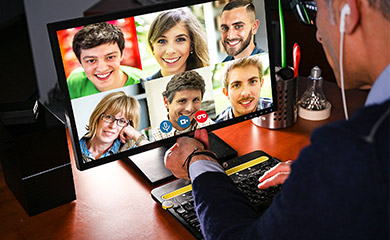
Humans are social creatures, but some are uniquely so.
These people—let’s call them “social butterflies”—strongly crave the physical touch of shaking hands, hugs or just close proximity. They love spontaneous, unfettered movement among people—a crowded cafeteria, say—where chance encounters lead to important business conversations.
And now, with coronavirus putting us all online, they are hurting badly. I hear it in their words. “Video just isn’t enough,” they say. I see it in their pained expressions on my computer screen. Even with a family at home, social distancing is brutal for these folks. You just can’t duplicate the elements of natural social interaction through a video screen.
Over the past few weeks Sierra Leadership has been seeking ways to help these people feel better. Here are our favorite suggestions for your work life and personal life.
For your work:
Squeeze more out of video. Systems like Google Meet and Zoom let you view just one person on the screen (large image) or the whole group (small images). Toggling between “speaker only” and group views can help you to feel more connected to the person talking, while still “reading the room.” Also, in a 1-1 meeting try asking the other person to get closer to their camera. A client did this spontaneously and I was surprised how much more intimate the conversation suddenly felt by virtue of clearer facial expression and less distracting background images. But don’t strain your eyes, and be sure to combat Zoom fatigue.
Create spontaneous informal chats. Prior to the shutdown, hallway conversations before and after meetings were important for connection and getting work done. Now those aren’t possible. Or are they? Try using the chat feature in your video system to ask one or two people to stay online for a couple minutes after a meeting. Try this even if you’re not completely sure of what you want to say. You can also use frequent quick check ins to lead with humanity.
Pick up the phone. It may be that the video screen doesn’t offer you as much feeling of connection as the simplicity and warmth of a voice-only phone call. Try it! The humble phone call has made a huge comeback during lockdown. Particularly if internet bandwidth brings distorted video, using just your voice can be less taxing, and provides a respite from hours of screen time. Try taking a walk while you talk—a great way to build in fresh air and exercise into a busy day.
Take more breaks. Many of us now spend the whole day in one room in front of one screen. That’s very different from walking from meeting room to meeting room, or going from site to site. Take a few deep breaths. Play some music. See how your kids are doing. Walk around the block. Tony Schwartz, an expert on peak performance recommends work periods (say, 90 minutes) followed by a break—at least one minute of deep breathing to clear stress chemicals.
On the personal side:
Get a dog. Or a cat. Or a rabbit. People who have not been pet owners are sometimes surprised at how much comfort and connection comes from having an additional mammal around the house. If adopting permanently is not practical, try offering temporary foster care for an animal. Or, if you’ve had pets before, maybe now is the right time to do so again.
Increase exercise. Exercise is a terrific mood enhancer and many of us have lost our exercise routines. Try to re-ignite it. Draw a line in the sand around your daily workout. If you are too overloaded, put on an exercise video and jump around with your kids for 20 minutes. Just keep moving! No equipment? Try mini-bands for a full body workout.
Get to know your family. You can’t butterfly your way through a crowded room, but you can connect on a deeper level with the people at home. If you live with a spouse or partner, you may feel like you’re getting enough of them. But quantity is different from quality. Maybe now is a good time to reconnect. John and Julie Gottman, after a lifetime of research on what makes a happy marriage, have put together 8 dates (you can do them at home) that help couples come together.
Pick up paintbrushes. Or another hobby. As the New York Times points out, a small hobby can have a big impact. If you’ve been working long hours for many years, you may have missed the pleasure of putting pen to paper, playing the recorder, or painting with watercolors, recently extolled eloquently by the Economist. I myself have spent some time with pastels, a soothing stress reducer.
Take care of your mind. Positive psychology teaches us that a gratitude journal, mindfulness of the present moment, and self-compassion make us happier. Now is the moment to double down on these. Like physical exercise, the more you put into these practices, the more you reap the rewards. Try setting aside some time before bed to work on these, alone or with your partner. Also, avoid responding to boredom or anxiety by reading coronavirus news—that’s the opposite of positive psychology! Be deliberate about when and how you consume your news. For me it’s in the morning on my stationary bike.
Perhaps the biggest challenge is that all of these things take effort. Grief over how the world has changed, and heavy workloads don’t help. So, even if you’re not a monarch social butterfly, pick one small thing that speaks to you and try it. Who knows? Years from now you might look back and see coronavirus as the catalyst for something you can’t live without.